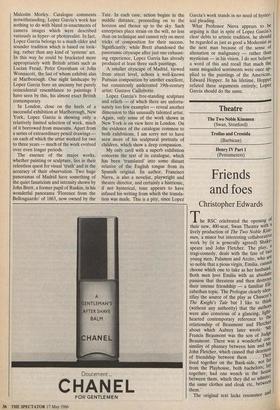Exhibitions
Antonio Garcia Lopez (Marlborough Fine Art till 31 May)
Madrid Realist
Giles Auty
For me, two events, in their different ways, have brightened the grey inclemency of the first days of May. First came the perennially cheering return of house mar- tins to the eaves of my home. Second I was lucky enough to be present at the opening of an exhibition of rare strength and quality by the Spanish painter and sculptor Antonio Lopez Garcia at Marlborough Fine Art (6 Albemarle Street, W1). Lacking regular contact with contempor- ary art circles in Spain, I cannot confirm that Lopez Garcia is widely regarded as that country's foremost living artist. If this were true, it would say much for Spanish Critical sensibilities and not too much for the organisers of supposedly representative exhibitions of European art in Britain who have yet to include him. At 50, the artist can undoubtedly build further on already solid achievements. A look through a catalogue of earlier works shows how far he has already come since student days in Madrid, 30 years ago. At that time his work shared something of the angular, unresolved quality of the early paintings of a British contemporary,Michael Andrews. Lopez Garcia has been described, wrongly I think, as a hyper-realist. If this were so it would tend to place him in the same,. essentially anti-art category as such Americans as Bechtle and Estes, or early Malcolm Morley. Catalogue comments notwithstanding, Lopez Garcia's work has nothing to do with bland re-enactments of camera images which were described variously as hyper- or photorealist. In fact, Lopez Garcia belongs to a much older and sounder tradition which is based on look- ing, rather than any kind of 'systems' art. In this way he could be bracketed more appropriately with British artists such as Lucian Freud, Peter Greenham or John Wonnacott, the last of whom exhibits also at Marlborough. One night landscape by Lopez Garcia bore an uncanny but purely coincidental resemblance to paintings I have seen by this, his almost exact British contemporary.
In London, close on the heels of a successful exhibition at Marlborough, New York, Lopez Garcia is showing only a relatively limited selection of work, much of it borrowed from museums. Apart from a series of extraordinary pencil drawings on each of which the artist worked for two to three years — much of the work evolved over even longer periods.
The essence of the major works, whether painting or sculpture, lies in their relentless quest for visual 'truth' and in the accuracy of their observation. Two huge panoramas of Madrid have something of the quiet fanaticism and intensity shown by John Brett, a former pupil of Ruskin, in his wonderful panorama 'Florence from the Bellosguardo' of 1863, now owned by the Tate. In each case, action begins in the middle distance, proceeding on to the horizon and thence up to the sky. Such enterprises place strain on the will, no less than on technique and cannot rely on mere tricks of composition for their success. Significantly, while Brett abandoned the panoramic cityscape after just one exhaust- ing experience, Lopez Garcia has already produced at least three such paintings.
A smaller cityscape of Madrid, viewed from street level, echoes a well-known Parisian composition by another excellent, but consistently underrated 19th-century artist: Gustave Caillebotte.
Lopez Garcia's free-standing sculpture and reliefs — of which there are unfortu- nately too few examples — reveal another dimension to this unusually talented artist. Again, only some of the work shown in New York is on view here in London. On the evidence of the catalogue common to both exhibitions, I am sorry not to have seen more of his sculptural portraits of children, which show a deep compassion.
My only cavil with a superb exhibition concerns the text of its catalogue, which has been 'translated' into some distant relative of the English tongue from its Spanish original. Its author, Francisco Nieva, is also a novelist, playwright and theatre director, and certainly a histrionic, if not hysterical, tone appears to have infused his writing from which the transla- tion was made. This is a pity, since Lopez Garcia's work stands in no need of hyster- ical pleading.
What Professor Nieva appears to be arguing is that in spite of Lopez Garcia's clear debts to artistic tradition, he should be regarded as just as good a Modernist as the next man because of the sense of alienation or malignancy — rather than mysticism — in his vision. I do not believe a word of this and recall that much the same misguided sentiments were once ap- plied to the paintings of the American, Edward Hopper. In his lifetime, Hopper refuted these arguments entirely; Lopez Garcia should do the same.



















































 Previous page
Previous page